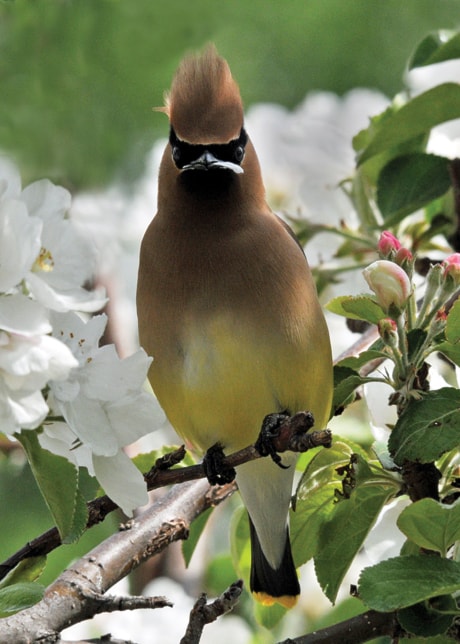Each spring, I enjoy watching Cedar Waxwings descend on our apple tree to gobble the delicate blossoms. They dine with such unabashed exuberance.
So named for the tiny red waxy globules on the tips of their secondary wing feathers, waxwings are social birds that travel together and fill the air with their high thin whistles. They are easy to identify by their brown and gray plumage, distinctive crests and black face masks.
There are two species in Alberta, the summer-dwelling cedar waxwing and the winter-visiting Bohemian waxwing.
In addition to blossoms, waxwings eat fruit and insects. They also have the interesting habitat of forming a bucket-brigade line on a branch, passing berries or insects up and down the row until one bird finally decides to swallow it. Mated pairs will also exchange food items.
Although their sleek demeanor gives them a regal air, it belies their gluttonous habits. They gobble whole pieces of fruit and will continue to gorge until they are unable to fly. They will also eat until their entire digestive system (literally, from beak tip to butt) is packed with food. In the spring, they will often eat fermented fruit and then stagger about in a drunken stupor.
Cedar Waxwings are one of our later nesting bird species. It is thought that they time their nesting cycle to coincide with the availability of fruit, especially saskatoons. Females, which are the primary nest builders, will sometimes scavenge nesting material from the nests of other birds, especially orioles, warblers and kingbirds. The four to six young, which are fed by both parents, leave the nest at 16 to 18 days of age.
Waxwings love to bathe. I have spent many a pleasant hour watching them splash about in the shallows of the water garden at Ellis Bird Farm. They bathe like they eat — energetically — and look quite comical when they emerge, dripping and disheveled. After a minute or two of serious shaking and preening, their beauty is restored and they fly off in search of yet another meal.
Myrna Pearman is the Biologist/Site Services Manager of Ellis Bird Farm. She can be reached at mpearman@ellisbirdfarm.ca.
